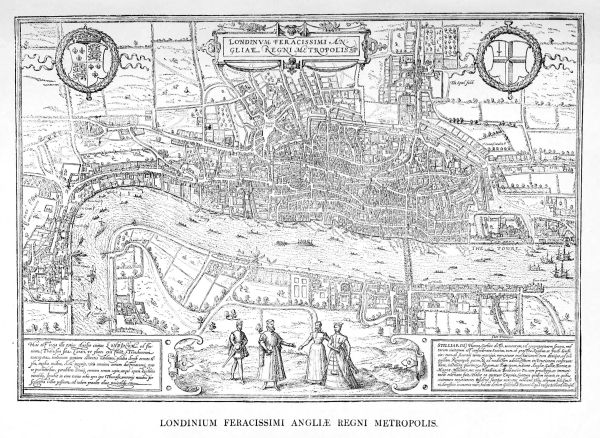MAPS
OF OLD LONDON
| I. | WYNGAERDE (IN THREE SECTIONS) |
| II. | AGAS |
| III. | SECTION OF AGAS |
| IV. | HOEFNAGEL |
| V. | NORDEN LONDON |
| VI. | NORDEN WESTMINSTER |
| VII. | FAITHORNE. |
| VIII. | OGILBY. |
| IX. | ROCQUE |
LONDON
ADAM AND CHARLES BLACK
1908
|
EDWARD STANFORD, Geographer to the King, 12, 13, and 14, Long Acre, London, W.C. |
"LONDINUM FERACISSIMI ANGLIÆ REGNI METROPOLIS"
By HOEFNAGEL
Description.—This map seems at first sight to be much less interesting than those which have preceded it, but that is due chiefly to its small size. The probable date is 1572, and even if otherwise unknown, it might have been judged approximately by the costumes of the figures in the foreground. It must have been contemporary with, or even earlier than, Agas, with whose work it is interesting to compare it. This map was made by Hoefnagel, and is taken from Braun and Hogenburg's work, Civitates Orbis Terrarum, in which Braun wrote the text, while Hogenburg and Hoefnagel engraved the maps. In the left-hand top corner are the arms of Elizabeth, and in the right-hand corner those of the City. In the later editions the delicately drawn figures in the foreground are omitted. In his notes on Old London Maps in the Proceedings of the Society of Antiquaries, vol. vi., Mr. W. H. Overall says it cannot be supposed that all the cities of the world engraved in Braun and Hogenburg's work were freshly surveyed for the purpose; and there are several points—such, for instance, as the inclusion of the steeple of St. Paul's, destroyed in 1561—which point to the fact that this version was probably taken from existing surveys. The original is 19 inches by 12¾ inches. The bull- and bear-baiting pits on the Surrey side are quite conspicuous, and so is the royal barge, in very much the same position in the river as it is in Agas's map. Here is a detailed account of it in Sir Walter Besant's own words:
Details.—"This is in some respects more exact than the better-known map attributed to Agas. The streets, gardens, and fields are laid down with greater precision, and there is no serious attempt to combine, as Agas does, a picture or a panorama with a map. At the same time, the surveyor has been unable to resist the fashion of his time to consider the map as laid down from a bird's-eye view, so that he thinks it necessary to give something of elevation.
"I will take that part of the map which lies outside the walls. The precinct of St. Katherine stands beside the Tower, with its chapel, court, and gardens; there are a few houses near it, apparently farmhouses. The convent of Eastminster had entirely vanished. Nothing indicates the site of the nunnery in the Minories, yet there were ruins of these buildings standing here till the end of the eighteenth century. Outside Bishopsgate houses extended past St. Mary's Spital, some of whose buildings were still apparently standing. On the west side St. Mary of Bethlehem stood, exactly on the site of Liverpool Street Station, but not covering nearly so large an area; it appears to have occupied a single court, and was probably what we should now consider a very pretty little cottage, like St. Edmund's Hall, Oxford.
"Outside Cripplegate the houses begin again, leaving between the Lower Moorfields dotted with ponds; there are houses lining the road outside Aldersgate. The courts are still standing of St. Bartholomew's Priory, Charterhouse, St. John's Priory, and the Clerkenwell nunnery; Smithfield is surrounded with houses; Bridewell, with its two square courts, stands upon the river bank; Fleet Street is irregular in shape, the houses being nowhere in line; the courts of Whitefriars are still remaining. The Strand has all its great houses facing the river; their backs open upon a broad street, with a line of mean houses on the north side. On the south of the river there is a line of houses on the High Street, a line of houses along the river bank on either side, and another one running near Bermondsey Abbey.
"Within the walls we observe that some of the religious houses have quite disappeared—Crutched Friars, for instance. There is a vacant space, which is probably one of the courts of St. Helen's. The Priory of the Holy Trinity preserves its courts, but there is no sign of the church. There are still visible the courts and gardens of Austin Friars. There is still the great court of the Grey Friars, but the buildings of Blackfriars seem to have vanished entirely" (London in the Time of the Tudors, p. 185).
